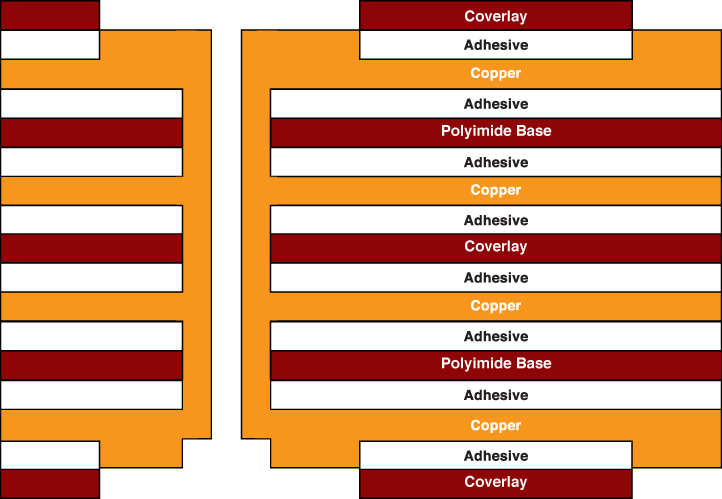
A Multilayer Flexible Printed Circuit Board (FPCB) is a type of circuit board that is flexible and consists of multiple layers of flexible substrate material. The basic structure of a multilayer flexible PCB typically includes the following components:
The base material of a flexible PCB is usually made of a flexible polymer, such as polyimide (PI) or polyester. Polyimide is a popular choice due to its excellent thermal stability and flexibility.
Thin layers of copper foil are laminated onto the flexible substrate. The copper serves as the conductive material for the circuit traces.
Adhesive layers are used to bond the copper layers to the flexible substrate. These layers provide mechanical strength and help maintain the flexibility of the board.
Cover lay is a protective layer made of a flexible material, usually polyimide or liquid photo imageable (LPI) solder mask, that is applied over the circuit traces. It protects the traces from environmental factors such as moisture, dust, and chemicals.
Prepreg (pre-impregnated) layers are sheets of partially cured resin that contain reinforcing materials. They are placed between copper layers and are fully cured during the lamination process. Prepreg layers provide additional insulation and bonding between copper layers.
Solder mask is a protective layer applied over the entire surface of the PCB, except for the areas where soldering is required (such as pads and vias). It helps prevent short circuits and provides additional protection against environmental elements.
The exposed copper surfaces are typically coated with a surface finish to protect them from oxidation and enhance solderability. Common surface finishes include immersion gold, HASL (Hot Air Solder Leveling), and ENIG (Electroless Nickel Immersion Gold).
Vias are conductive paths that connect different layers of the PCB. In multilayer flexible PCBs, these are typically achieved using plated through-holes or laser-drilled micro vias.
In some cases, a multilayer flexible PCB may have a flexible tail, which is an extended portion of the board designed for connecting to other devices or systems.

10. Multilayer flexible PCB reinforcing board (PI Stiffener Film)
Reinforcement board: It reinforces the mechanical strength of FPC and facilitates surface mounting operations. Common thicknesses range from 3 mils to 9 mils.
Glue (adhesive): Thickness depends on customer requirements.
Release paper: It prevents the adhesive from sticking to foreign objects before pressing.
EMI: Electromagnetic shielding film protects the circuit inside the circuit board from external interference (strong electromagnetic area or susceptible area).
The number of layers in a multilayer flexible PCB can vary, and the specific design depends on the requirements of the electronic device it is intended for. The flexibility of the board allows it to be bent or folded to fit into tight spaces or conform to specific shapes, making it suitable for applications where traditional rigid PCBs may not be practical.